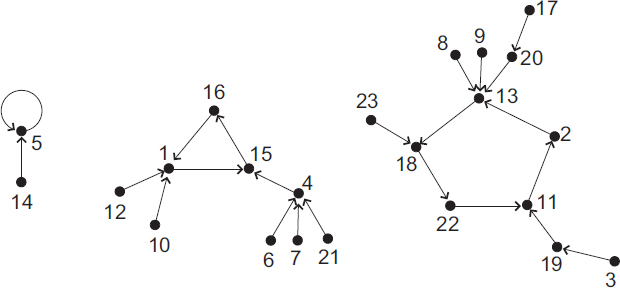17.3 Random Mappings
While in the previous section we considered a particularly simple kind of random graphs, we now turn to slightly more complex graphs. Random mappings are mappings from an n element set M into itself where uniform distribution is assumed. Obviously, any such mapping gives rise to a directed graph: Draw n points in the plane and label them with the elements of M. Then draw a directed edge from i to j (i, j ∈ M) whenever the mapping maps i onto j. This graph is called the functional digraph of the mapping and allows an easy decomposition. Each component contains exactly one cycle (which may be a loop) and to each vertex of the cycle is attached a Cayley tree (i.e., a labeled rooted tree). So a functional digraph decomposes into a multiset of cycles of labeled tree (see Figure 17.2 for an example).

Figure 17.2 A random mapping on M = {1, 2,...,23}.
From this decomposition it is easy to derive the GF for the numbers of such mappings. It is well known (cf. [24]) that the multiset and cycle construction for labeled objects correspond to ez and log(1/(1 – z)) for the exponential GFs. Hence the exponential GF is
![]()
where a(z) is the GF for Cayley trees, given by the functional equation
Of course, elementary enumeration shows that [zn]A(z) = nn/n! such that the above decomposition ...
Get Analysis of Complex Networks now with the O’Reilly learning platform.
O’Reilly members experience books, live events, courses curated by job role, and more from O’Reilly and nearly 200 top publishers.

